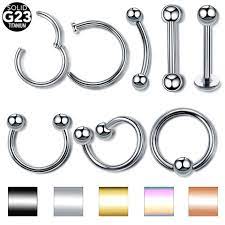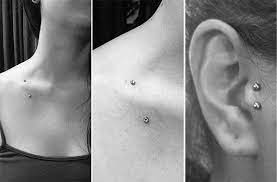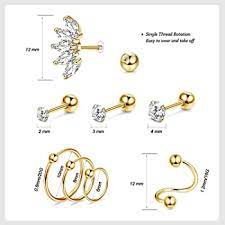Views: 26 Author: Site Editor Publish Time: 2023-06-30 Origin: Site
When it comes to body piercings, selecting the right jewelry is crucial for both style and safety. Titanium and stainless steel are two popular materials used in piercing jewelry. In this blog, we will explore the characteristics, benefits, and considerations of titanium and stainless steel, helping you make an informed choice for your body piercings.
Titanium has gained immense popularity in the world of body piercing due to its exceptional properties. First and foremost, titanium is hypoallergenic, making it an excellent choice for individuals with sensitive skin or metal allergies. It is considered one of the safest materials for initial and healed piercings, minimizing the risk of irritation or allergic reactions.

Moreover, titanium is lightweight, making it comfortable to wear. Its durability and resistance to corrosion ensure that your jewelry will remain in good condition even after prolonged use. Titanium is also biocompatible, meaning it does not react with body tissues, reducing the chances of infection or rejection.

Another advantage of titanium is its versatility in terms of color. It can be anodized to produce vibrant hues, allowing for a wide range of customization options to match your personal style.
Stainless steel is another popular choice for body piercings. It offers several advantages that make it a preferred option for many individuals. First and foremost, stainless steel is highly durable and resistant to tarnish and corrosion. This makes it suitable for long-term wear, even in moist environments such as showers or swimming pools.
Stainless steel is also cost-effective compared to titanium, making it a more budget-friendly option for those looking for stylish yet affordable jewelry. It is widely available and comes in various designs, shapes, and sizes, catering to different piercing preferences.

However, it is worth noting that stainless steel contains traces of nickel, which may cause allergic reactions in individuals with nickel sensitivities. While many people can comfortably wear stainless steel without any issues, those with known sensitivities should exercise caution or opt for alternative materials like titanium.
In the debate between titanium and stainless steel piercing jewelry, both materials have their unique advantages. Titanium offers hypoallergenic properties, lightweight comfort, and vibrant colors, making it an ideal choice for individuals with sensitive skin. On the other hand, stainless steel is highly durable, affordable, and widely available, appealing to those seeking budget-friendly options. Ultimately, the decision boils down to personal preferences, skin sensitivities, and budgetary considerations. Regardless of your choice, it's crucial to prioritize safety, quality, and proper aftercare for a successful and enjoyable piercing experience.